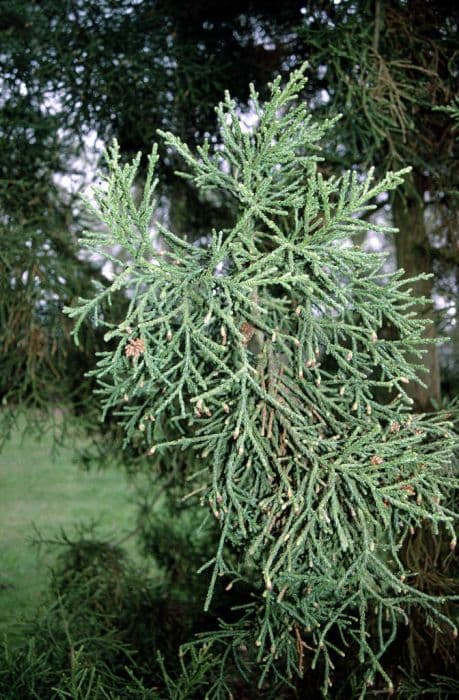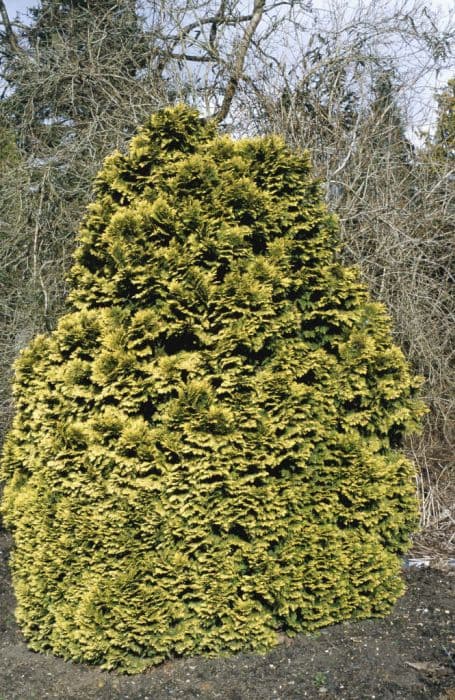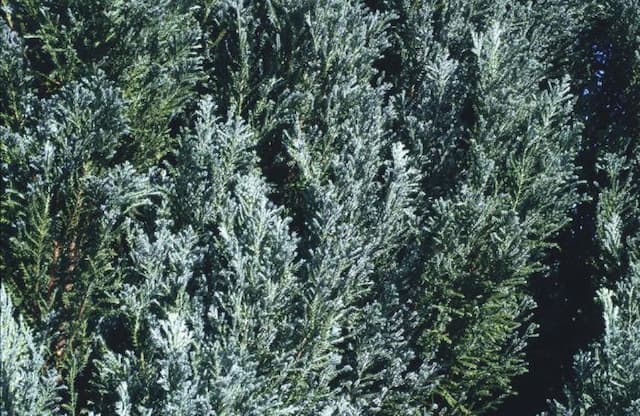Golden Dwarf Hinoki Cypress Chamaecyparis obtusa 'Tetragona Aurea'

ABOUT
The Hinoki cypress 'Tetragona Aurea' is a visually striking plant, notable for its unique foliage and overall texture. The leaves of this cultivar are scale-like and grow in dense sprays. As the name 'Aurea' suggests, the foliage has a golden hue, particularly at the tips, which becomes more vibrant with exposure to the sun. The color is a mix between a soft golden-yellow and green, giving the plant a shimmering appearance that stands out in the garden. The branches of the Hinoki cypress 'Tetragona Aurea' tend to grow in a somewhat irregular fashion, creating a somewhat twisted and sculptural form. Over time, this gives the plant a rugged, yet elegant stature that is often praised in landscaping for its aesthetic appeal. The bark is a warm reddish-brown and peels off in strips, adding to its textured look. Additionally, the cones are small, globular, and not particularly conspicuous. The overall impression of the Hinoki cypress 'Tetragona Aurea' is of a plant that provides year-round interest with its evergreen foliage and unique coloration, making it a favorite for gardens that aim to display a sense of both structure and natural beauty. It has a particular elegance that allows it to be used as a focal point or as part of a larger composition with other plants to create varied textures and colors in the landscape.
About this plant
 Names
NamesFamily
Cupressaceae
Synonyms
Golden Hinoki Cypress, Golden Japanese Cypress, Aurea Tetragona Hinoki Cypress
Common names
Chamaecyparis obtusa 'Aurea', Chamaecyparis obtusa 'Lutea', Retinispora obtusa 'Aurea', Retinispora obtusa 'Tetragona Aurea', Cupressus obtusa 'Tetragona Aurea'.
 Toxicity
ToxicityTo humans
The plant in question, commonly known as Hinoki cypress, is not typically considered toxic to humans. There is no common documentation of poisoning or toxic effects from ingesting or handling the Hinoki cypress. However, as with any plant material, individual allergies and sensitivities can occur, so it is generally advised not to ingest plant parts.
To pets
The Hinoki cypress does not appear on lists of plants commonly known to be toxic to pets, including cats and dogs. As such, there are no specific symptoms of poisoning attributed to this particular plant. However, ingesting non-food items, including parts of any plant, can potentially lead to gastrointestinal upset or blockage in pets, so it is still advisable to monitor your pet and prevent them from consuming this or any plant material.
 Characteristics
CharacteristicsLife cycle
Perennials
Foliage type
Evergreen
Color of leaves
Green
Height
2-3 feet (0.6-0.9 meters)
Spread
2-3 feet (0.6-0.9 meters)
Plant type
Tree
Hardiness zones
5
Native area
Japan
Benefits
 General Benefits
General Benefits- Ornamental Appeal: Adds aesthetic value to landscapes with its unique golden-yellow foliage and interesting texture.
- Habitat Support: Provides shelter and nesting sites for various species of birds and other wildlife.
- Low Maintenance: Requires minimal care once established, making it a convenient choice for busy gardeners or those seeking low-effort landscaping options.
- Drought Tolerance: Once established, it can withstand periods of dry weather, reducing the need for frequent watering.
- Privacy Screen: Can be used as a living privacy screen or hedge due to its dense growth habit.
- Year-Round Interest: The evergreen nature of the plant ensures that it provides color and structure in the garden throughout all seasons.
- Soil Erosion Control: Its root system can help stabilize the soil, preventing erosion on slopes and in areas prone to surface runoff.
- Windbreak: When planted in rows or groups, it can act as a windbreak, protecting gardens and homes from strong winds.
- Versatile Landscaping: Suited for a variety of landscaping designs, from formal hedges to specimen plantings in mixed borders.
- Cultural Significance: Often used in bonsai cultivation, providing an opportunity for gardeners to connect with the art and tradition of bonsai.
 Medical Properties
Medical PropertiesThis plant is not used for medical purposes.
 Air-purifying Qualities
Air-purifying QualitiesThis plant is not specifically known for air purifying qualities.
 Other Uses
Other Uses- Hinoki wood is highly resistant to rot and its aromatic quality repels insects, making it a choice material for building storage chests and closets.
- The wood's excellent acoustic properties allow it to be used in construction of instruments like violins and pianos.
- Due to its fine grain and aesthetic appeal, Hinoki is a popular wood for constructing traditional Japanese tea houses.
- Hinoki cypress branches are often used in bonsai, creating miniature landscapes that are appreciated for their artistic value.
- The tree's dense foliage can be used in creating privacy screens in gardens and urban spaces.
- Its slow growth and sculptural form make Hinoki a coveted specimen for ornamental horticulture and theme gardens.
- The fragrant wood is sometimes used in the crafting of luxury bath accessories, such as bath mats and buckets, which complement a serene bath setting.
- When used in shipbuilding, Hinoki wood offers durability and resistance to water, making it suitable for certain marine applications.
- The essential oils from Hinoki can be extracted and used in aromatherapy for their relaxation and stress-relieving properties.
- Hinoki sawdust and wood shavings can be used as a natural mulch or in the production of pressed wood items.
Interesting Facts
 Feng Shui
Feng ShuiThe Hinoki Cypress is not used in Feng Shui practice.
 Zodiac Sign Compitability
Zodiac Sign CompitabilityThe Hinoki Cypress is not used in astrology practice.
 Plant Symbolism
Plant Symbolism- Longevity: The Chamaecyparis obtusa 'Tetragona Aurea', commonly known as the Gold Hinoki Cypress, is a slow-growing conifer often associated with longevity due to its potential to live for several centuries.
- Strength: The wood of the Gold Hinoki Cypress is known for its resistance to rot and durability, symbolizing strength and resilience.
- Peace: In Japanese culture, hinoki wood is traditionally used in temples and shrines, signifying peace and tranquility.
- Sacredness: The tree is considered sacred in Shinto religion, indicating purity and making it a symbol of the sacred.
- Prosperity: Because of its golden leaves, the Gold Hinoki Cypress can be seen as a symbol of prosperity and good fortune.
 Water
WaterThe Golden Hinoki Cypress should be watered regularly with the aim of keeping the soil evenly moist, but not waterlogged. During the growing season in spring and summer, water the plant about once a week with 1 to 1.5 gallons, depending upon the size of the plant and the ambient temperature. In fall and winter, reduce the frequency to every two weeks or even less, depending on the weather conditions and soil moisture levels. It's essential to adjust your watering schedule based on rainfall and drought conditions to prevent root rot. Always check the top couple of inches of soil for moisture before watering again.
 Light
LightThe Golden Hinoki Cypress will thrive best in a spot that receives full sun to partial shade. Ideally, this plant should be placed where it can get at least four to six hours of direct sunlight each day. When selecting the best location, also ensure it’s not exposed to harsh afternoon sun in hot climates, as this may scorch the foliage.
 Temperature
TemperatureThe Golden Hinoki Cypress is hardy and can tolerate a range of temperatures, but it prefers a cooler climate. It can generally survive minimum temperatures down to about -20°F, but may get damaged or suffer if exposed to such extremes for prolonged periods. The ideal growing temperature ranges from 60°F to 70°F during the day, although it will tolerate higher temperatures if not accompanied by dry conditions.
 Pruning
PruningThe Golden Hinoki Cypress should be pruned to maintain its shape and size and to encourage healthy, dense growth. The best time to prune is in the late winter or early spring before new growth starts. Pruning can be done yearly, but light trimming throughout the growing season is also acceptable to remove any dead or diseased branches and to shape the plant as desired.
 Cleaning
CleaningAs needed
 Soil
SoilThe best soil mix for the Hinoki Cypress should be well-draining with a mix of loam, peat, and sharp sand, ensuring it is slightly acidic to neutral in pH, aiming for a pH range between 5.0 and 7.0.
 Repotting
RepottingThe Hinoki Cypress should be repotted every two to three years to refresh the soil and accommodate the growth of the root system.
 Humidity & Misting
Humidity & MistingThe Hinoki Cypress thrives in moderate to high humidity levels, ideally between 50% to 70%.
 Suitable locations
Suitable locationsIndoor
Place Hinoki Cypress in bright, indirect light with high humidity.
Outdoor
Plant in well-draining soil, partial shade to full sun.
Hardiness zone
4-8 USDA
 Life cycle
Life cycleThe Hinoki cypress 'Tetragona Aurea' begins its life as a seed, typically requiring a well-draining soil medium and some moisture to germinate. Once sprouted, the seedling grows into a young sapling, experiencing a slow growth rate and gradually developing the characteristic yellow-tipped, fan-shaped foliage of this cultivar. As the plant matures, it enters a prolonged vegetative state, during which it will slowly grow into a densely branched, conical or pyramidal-shaped evergreen, reaching up to 3-6 feet tall and 2-4 feet wide in cultivation. Throughout its life, it requires partial to full sun exposure and regular watering, but it is relatively drought tolerant once established. After many years, it may produce small, inconspicuous cones, but in garden settings, it is primarily valued for its ornamental foliage rather than for reproduction. The life span of the Hinoki cypress 'Tetragona Aurea' can extend well over a century in ideal conditions, with minimal care required after it has fully established.
 Propogation
PropogationPropogation time
Spring-Early Summer
The Hinoki cypress 'Tetragona Aurea' is often propagated by taking semi-hardwood cuttings. This is typically done during the summer months when the new growth has begun to mature and harden slightly. To propagate using this method, cut a 4- to 6-inch (10 to 15 cm) length from a healthy branch, ensuring there are several nodes present. Remove the lower leaves to reveal a clear stem and dip the cut end in rooting hormone powder to encourage root development. The cutting should then be placed in a well-draining soil mixture, ensuring the nodes are buried as roots will emerge from these points. The soil should be kept consistently moist and the cutting should be placed in a location with indirect sunlight. Rooting generally takes several weeks, after which the cutting can be gradually acclimated to typical growing conditions before being transplanted to its final location.









